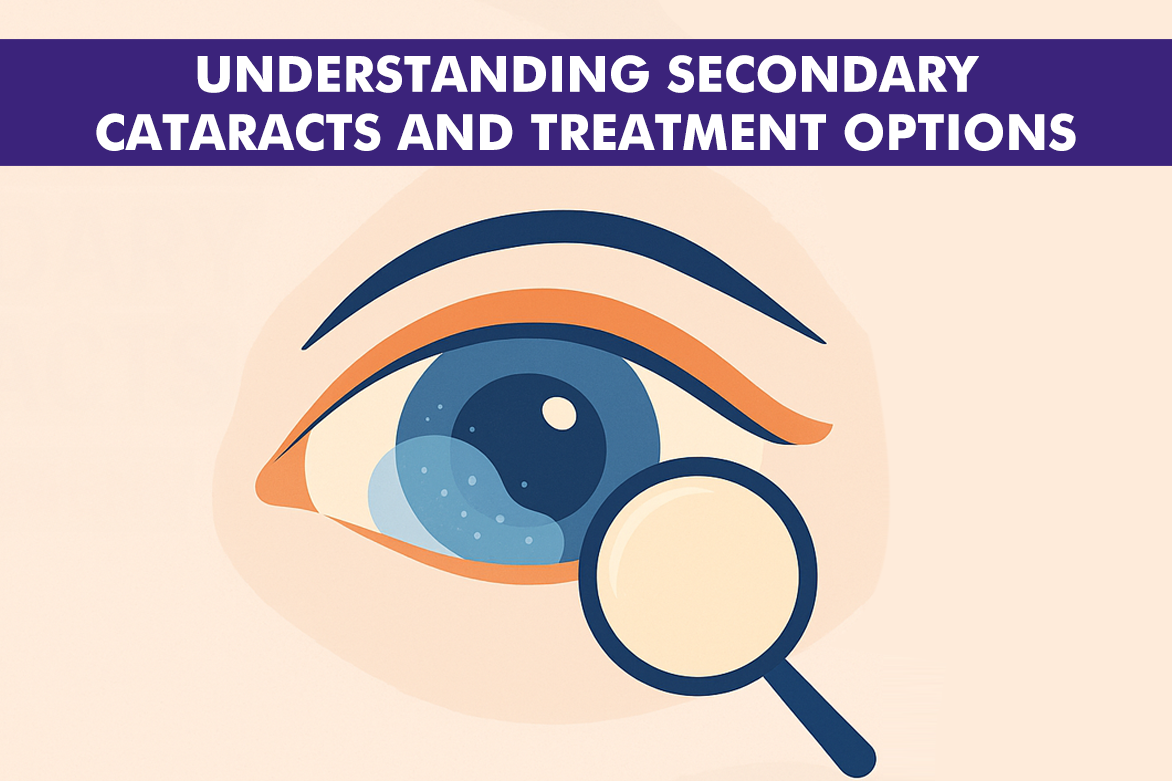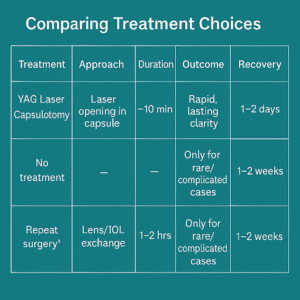Table of Contents
- What Are Secondary Cataracts?
- Symptoms and Diagnosis of Secondary Cataracts
- Causes and Risk Factors Associated with Secondary Cataracts
- How Are Secondary Cataracts Diagnosed?
- Available Treatment Options for Secondary Cataracts
- Preventive Measures to Minimize Secondary Cataracts
- Do Secondary Cataracts Come Back?
- Conclusion
- FAQs
For many, cataract surgery is expected to be the grand finale of vision problems—restoring the crisp clarity of youth with a few brief minutes in the operating room. While it’s true that cataract surgery rates among the safest and most reliable medical procedures, some patients are surprised to experience cloudy vision months or years after a “perfect” surgery. This is where secondary cataracts, or posterior capsule opacification (PCO), enter the picture. The answer to “what is a secondary cataract” is that it’s a common yet highly treatable cause of post-surgical visual troubles.
This comprehensive guide will demystify secondary cataracts, highlight the latest diagnostic and secondary cataract surgery advances, and equip you with proactive tips for lifelong visual health.
What Are Secondary Cataracts?
Contrary to what the name might suggest, secondary cataracts are not a regrowth of the original cataract. Instead, after the natural cloudy lens is removed and replaced by an artificial intraocular lens (IOL), some residual lens epithelial cells begin to multiply and migrate along the back part (posterior capsule) of the lens capsule. This cell layer gradually becomes cloudy, scattering light and mimicking the same vision issues patients faced pre-surgery.
Fact Check
- Secondary cataracts are the most frequent long-term complication of cataract surgery, occurring in up to 30% of patients.
- They can develop anywhere from a few months to several years after the original operation.
Symptoms and Diagnosis of Secondary Cataracts
The symptoms are deceptively similar to those of primary cataracts, often leading to confusion or frustration for patients. Common signs include:
- Blurred or hazy vision, making it hard to see details
- Glare or sensitivity to bright lights, especially while driving at night
- Faded colors and decreased contrast, which dull your world
- Difficulty reading or using screens, even with strong glasses
- Seeing halos around lights
Causes and Risk Factors Associated with Secondary Cataracts
While secondary cataracts can affect almost anyone after surgery, several factors can increase your risk:
- During cataract surgery, not all lens epithelial cells can be removed from the capsule; these leftover cells may multiply.
- These cells migrate to the posterior capsule and form a thin, cloudy layer, gradually obscuring the visual axis.
Risk Factors of Secondary Cataracts Include:
- Younger age at the time of cataract surgery (cells are more active)
- Certain IOL designs and materials may influence the rate of cell growth
- Pre-existing eye inflammation or complicated surgery
- Diabetes or specific systemic conditions
- Incomplete removal of the lens cortex during the initial procedure
Did You Know?
Modern surgical techniques and advanced lenses have reduced—but not eliminated—the likelihood of PCO. Discussing IOL type with your surgeon may help optimize your outcome.
How Are Secondary Cataracts Diagnosed?
A thorough diagnosis is critical—not all blurry vision after cataract surgery is due to secondary cataracts. Other causes can include dry eye, retinal swelling, or IOL problems.
What To Expect During Diagnosis of Secondary Cataracts:
- Visual acuity assessment to determine the vision impairment level
- Slit-lamp exam: The doctor may dilate your eyes to view the capsule and IOL more clearly
- Imaging: Optical Coherence Tomography (OCT) can rule out macular edema or other retinal issues
- Rarely, a digital photograph may record the extent of capsule opacification for future comparison
Available Treatment Options for Secondary Cataracts
The standard secondary cataract treatment is the YAG (yttrium-aluminum-garnet) laser capsulotomy—a marvel for its effectiveness and convenience.
What is YAG Laser Capsulotomy?
- A non-invasive, outpatient laser procedure (no incisions, stitches, or anesthesia needed)
- The laser creates a tiny opening in the cloudy capsule to restore the unobstructed passage of light
- Takes just 5–10 minutes in the ophthalmologist’s office
Benefits and What to Expect During YAG Laser Capsulotomy:
- Immediate dramatic improvement for most patients—often noticeable within a day
- Painless and quick; vision usually recovers fully within 24–48 hours
- No need to “repeat” cataract surgery; the artificial lens remains in place
Preventive Measures to Minimize Secondary Cataracts
Complete prevention is impossible, but you can lower your risk with proactive care:
- Discuss modern, sharp-edged IOL implants and materials with your surgeon—some lenses are designed to resist cell migration and PCO formation.
- Ensure your surgeon uses thorough lens removal techniques.
- Attend all scheduled post-op appointments; early inflammation and cell build-up can be managed more effectively when detected early.
- Control underlying health conditions (like diabetes or uveitis) and avoid eye trauma after surgery.
- Manage chronic eye dryness: A healthy tear film protects eye tissues and may help reduce complications.
Do Secondary Cataracts Come Back?
Once secondary cataract treatment (YAG laser capsulotomy) is done, it is virtually unheard of for secondary cataracts to return—the capsule does not re-cloud after being opened by the laser. Occasionally, a patient may need a minor additional laser procedure if some cloudiness remains, but this is rare.
Tip for Patients: Regular eye exams remain essential to ensure other complications, such as retinal detachment or glaucoma, do not develop after the procedure.
Conclusion
While secondary cataracts can be a frustrating surprise after cataract surgery, they are among the easiest and most effectively treated conditions in eye care. Recognizing the signs, seeking prompt attention, and understanding the simple, safe nature of YAG laser capsulotomy can empower you to maintain clear vision for years to come. Stay proactive with regular eye exams—your ophthalmologist is your best partner on the path to lifelong, sharp sight.






